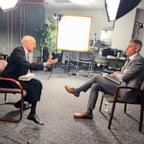Save Big by Making Easy, Painless Tweaks to Your Family Finances
'GMA's' Savings Makeover finds $188,852 in savings for one family.
March 11, 2010— -- What if you could save tens of thousands of dollars by making a few painless tweaks to your family finances? That's what I have been teaching people to do in our "Good Morning America" Savings Makeovers. When my bosses decided they would offer my savings services to our viewers, hundreds of you responded by signing up right here on the Web site. I read all the entries and chose the Strickland family of Purcellville, Va., for this second Savings Makeover.
(Click here to see the first Savings Makeover, where I found $46,993 in savings for a Baltimore family.)
Once I have gathered the details of a family's finances, here's how I search for savings for them. Basically, I use my book, "Save Big," as a 338-page cheat sheet. (Click here to read the introduction to "SAVE BIG." Click here to read a free sample chapter about Creative Couponing, which can save you as much as 80 percent on groceries.)
There are 110 big savings strategies in the book, each with the potential to save you at least $1,000 on your most common expenses. This time I used half a dozen of these great, easy tricks to help the Stricklands save $188,852.
The Stricklands have made some wise money moves on their own, so I went into this makeover nervously, wondering whether I could really help them. But Mike and Kim Strickland have seven children, so their expenses are understandably high.
"It's that many more children to try to send through college," Kim Strickland said, "So you have to be smart with how you spend your money."
That was my opening. I realized that some of the same expenses that everybody struggles with would be even costlier for the Stricklands because they're multiplied times nine people. They needed to cut costs on some of the big, boring expenses in life so they would have more money to put toward those college educations.
Cell Phone Bills: Pattern = Plan
My first target was their cell phone bill. The Stricklands were paying $578 a month for six cell phones. Ouch! I asked FixMyCellBill.com, powered by Validas, to analyze their cell phone bills and look for savings. This innovative Web site does what human brains cannot: It analyzes several different providers and hundreds of different calling plans to find the one that fits your pattern best. With cell phones, pattern = plan. That is the key to saving big.
Sure enough, FixMyCellBill.com found $829 in annual savings for the Stricklands. They were paying for more minutes than they actually used. "We suspect that you can save an additional $240 a year by lowering your minute plan again," Todd Dunphy of Validas, the company behind FixMyCellBill.com, told the family.
Other targets: The Strickland's talk and text time was not allocated as strategically as it could have been. (The Stricklands have a 14-year-old daughter. Need I say more?) And they had not registered the numbers they call most with their carrier. Some cell phone carriers have programs in which calls to your top numbers are free, but you must register those numbers. (Tip: Check before registering numbers that are with the same carrier. Those in-network calls are likely free already.)
To have Validas analyze your cell phone bill, go to www.FixMyCellBill.com. It costs $5 for feedback on a single bill, and a bit more to analyze multiple bills. But right now, Validas is offering "GMA" viewers a 20 percent discount. Just enter the words "Save Big" in the promotional code box, and any service you use will be adjusted down by 20 percent.
Cash Back Credit Cards
Carrying credit cards that fit your lifestyle is also important, sort of like the pattern = plan advice for cell phones. People who carry a balance should get the lowest interest rate cards they can. (If that is you, don't be discouraged. There are clever ways to pay down that debt faster and save money doing it and they're here and in my book, "Save Big.") But once those cards are paid off, you want to switch to cards with rich rewards. There was a time when Mike and Kim Strickland had credit card debt, but they are fortunate that they don't anymore, so they should be taking advantage of rewards cards that give you money when you spend money.
Click here to learn where you can find a copy of "Save BIG" by Elisabeth Leamy, ABC News Consumer Correspondent.
Click here for more savings resources available on Elisabeth Leamy's Web site.Food for this big family of nine costs about $300 a week -- $15,000 a year -- simply because there are so many mouths to feed. Kim shops at a Super Target that carries groceries, but she didn't realize that Target just started offering price matching. All you do is find the best sale items in all the competing store circulars, and Target will honor them. Click here to read the details of Target's price-matching policy. Walmart also price matches. And there is usually at least one local store in each town that does as well.
I showed Kim a quicker, easier, better way to price match. Poring over store circulars can be counterproductive, because they hype "2 for $5" and things like that, but you don't necessarily know if that is a good deal or not because they rarely state the percentage off the original price. I suggested Kim start, instead, by going to www.CouponMom.com, a free Web site that is valuable even if you don't use coupons. The site shows all the deals in most weekly store circulars. More important, it lists the percentage discount you are getting, so you can cherry pick the items that meet your idea of a bargain. I like to focus on those that are at least 50 percent off. You can print out a custom shopping list from CouponMom.com, then just take the circulars, whole, to the store with you as proof.
"Are you willing to put in just a little extra work to save as much as 40 percent -- $6,240 on your groceries?" I asked Kim.
"I think once you realize the amount you're going to save, you can come to terms with the little bit of work that it's going to take, so definitely," she replied.
Health Insurance: Group Versus Individual
Mike is a veterinarian and owner of Leesburg Veterinary Hospital in Leesburg, Va., so the Stricklands have always purchased group health insurance through an association he belongs to, assuming being part of a group was the cheapest way to go. The cost when I met them? About $12,000 a year for their family of nine. Yikes. Believe it or not, it's sometimes less expensive for healthy people to buy individual plans, because group plans have to pad their rates to make up for all the unhealthy people who join. Another reason individual plans can be cheaper is that often employers don't offer employees many choices. An individual plan can sometimes be tailored better to your specific circumstances.
So I arranged for Donna Alcorn of Rust Insurance, a Trusted Choice agency, to shop around for the Stricklands. Consulting an independent broker like Alcorn is a great one-stop way to shop for health insurance, because they have access to lots of different companies and can compare and contrast for you.
Click here to find an independent Trusted Choice agent near you.
It worked for the Stricklands. By switching to an individual plan with another big, well-known insurance company, and inching their deductibles up just a couple hundred dollars, (they rarely met them anyway) Donna was able to cut their healthcare costs by more than half.
"The annual savings by switching carriers is $6,756," Donna announced to the Stricklands.
"That is phenomenal," Kim said. "When I think about how much we've spent, it makes me a little bit ill that we didn't do this sooner."
You may be wondering if people like the Stricklands are giving up some security, in the event that they come down with a serious medical problem, when they switch from a group to an individual plan. Turns out, it's not like car insurance where if you have an accident the company raises your rate. If you are diagnosed with a disease that is expensive to treat, the health insurance company does not raise your rate for that. Health insurance rates are determined by the carrier's book of business and the overall claims in your state, not your individual situation. For that reason, Alcorn said, it's helpful to shop around for health insurance every year or two because your rate can change for reasons that have nothing to do with you.
You can pay off your closing costs in 5 years or less, preferably much less.
You will not add more than five years to the length of your loan.
The Strickland's case meets all three of these standards. With interest rates so low, a half point -- or 0.65 points in their case -- makes up a bigger percentage of the rate than it did back in the days of double-digit interest rates. The new interest rate will make up for the closing costs and pay for itself in about four years, more than I would prefer, but still reasonable.
Because the Stricklands have 23 years left on their mortgage, I found them loans with lengths of 23 and 25 years. Many people make the mistake of refinancing into another 30-year loan when they are well into their mortgage. That reduces their monthly payment but reduces or eliminates their long-term savings because it stretches the interest payments out over several more years. Bottom line: the Stricklands will save nearly a thousand dollars a year by refinancing, and a total of $18,171 over the life of their new loan.
Refinancing Your Home Equity Line
I also suggested the Stricklands refinance their home equity line. Their case is somewhat unusual because their HELOC was not taken out in conjunction with their main mortgage. They got it later, from a different bank, to finance building a barn on their property. They live in the country and board other people's horses on their land to make some extra money and maintain their agricultural status with the county tax office, which gives them lower property taxes. (Like I said, they are financially savvy and my task was to take their savings efforts to the next level.)
The Strickland's existing HELOC was at Prime Plus two points, in other words, 5.25 percent, and it was structured as an interest-only loan, so they were not required to pay any principal, which worried me. I asked some big banks if they could do better than 5.25 percent and they said "nope," that was the going rate. But then one banker let slip that if the Stricklands belong to a credit union, they might find a good HELOC rate there. They do and they did. Their credit union offers a HELOC at just 3.99 percent. What a deal.
The new loan requires principal and interest payments, so that will keep the Stricklands honest. And let's just say they take 15 years to pay it off. They will save $6,637 in interest with the new interest rate. If you do not belong to a credit union, don't despair. It's much easier to find one that you qualify for these days. Check out the Web site www.findacreditunion.com to get started.
Prepaying Your Mortgage
The savings strategies we've discussed so far are immediate. They will save the Stricklands $16,214 this year, and every year. That's what I mean when I say "Save Big." Woo-hoo! But there's a way for the Stricklands to save even bigger. If they role some of that immediate savings into prepaying their mortgage, their savings can transform from a five-figure number to a six-figure one.
Paying extra toward your mortgage saves you money because you pay down your principal, which gives the bank less principal to charge you interest on. (Tip: You have to make sure you don't owe a prepayment penalty and that your bank applies your extra payment to the principal, not the interest. Some banks require you to write a separate check or make a separate online payment to make your intentions clear.) Because mortgages are big debts over a long period of time, the reverse compounding feels downright miraculous. To see how much money you could save by prepaying your mortgage, click here for a great calculator.
If the Stricklands were able to commit $200 extra per month toward their mortgage principal, it would save them $40,778 over the rest of the loan. About $500 in extra principal would garner an $82,985 savings. And if they can swing $1,000 in extra principal per month on a 25-year loan, they will save $148,620 and pay their mortgage off 11 years early.
This most ambitious plan may actually be possible for the Stricklands not only because of the savings I found for them, but also because they were already trying to pay a chunk of extra money toward their home-equity line each month. That is a smaller loan at a lower interest rate and you can save money by paying the loans with the highest interest rates first. So, I advised them to redirect those funds to prepaying their mortgage instead and just pay the minimum on their home equity line.
"It's going to take diligence to do it, but having advice on how to redirect our money has made a big difference," Mike Strickland said. "And I'm excited about that."




